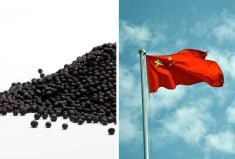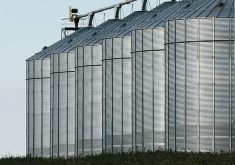It looks like freight rates charged by Canada’s major railway companies to move western Canadian grain to market will be likely going down in the 2015-16 crop year.
The Canadian Transportation Agency (CTA) announced April 29 that the formula used to determine railway revenue caps for grain, or maximum revenue entitlements, has been adjusted downward to reflect lower-than-expected input costs at the country’s major railway companies — Canadian Pacific Railway and Canadian National Railway.
According to the CTA, the Volume-Related Composite Price Index or VRCPI, will be reduced by 5.6 percent in the 2015-16 crop year beginning Aug. 1.
Read Also

Canada and China discuss disputes over canola and EVs, says Ottawa
Senior Canadian and Chinese officials discussed bilateral trade disputes involving canola and electric vehicles on Friday, Ottawa said, but gave no indication of any immediate breakthrough.
The VRCPI is an inflation-related factor used to determine the maximum amount of revenue that can be earned by railways for moving a tonne of prairie grain through regulated railway corridors to Thunder Bay, Vancouver and Prince Rupert.
The VRCPI limits the amount of revenue that CN and CP can charge for moving a tonne of grain but it does not limit how much grain the railways can move in total.
According to the CTA , the 5.6 percent decrease announced this week reflects adjustments to previously estimated railway input costs on items such as diesel fuel, hopper car leases, car maintenance costs and capital.
Of the 5.6 percent reduction, 4.1 percent was attributed to replacing last year’s input costs forecasts with revised or actual railway costs.
The remaining 1.5 percent decrease was due to forecasted input price changes for the upcoming crop year.
“The 4.1 percent decrease is largely attributable to the agency having over forecasted the change in railway fuel prices for the 2014-15 crop year,” the CTA decision explains.
“As well, last year’s 2015 forecast for the price of crude oil was much higher than this year’s. In (Canadian dollar) terms, the agency had forecasted $100.45 CAD (per barrel) for 2015 last year and is now forecasting $66,79 per barrel.”
In recent years, fluctuations in the VRCPI have been largely due to volatility in fuel prices, the agency noted.
The VRCPI rose by 9.7 percent in 2012-13.
That was followed by a 1.8 percent decrease in 2013-14, and a 4.5 percent increase in 2014-15.
The 5.6 percent increase established for the 2015-16 crop year is the second largest decrease recorded in the past 15 years.
The VRCPI is now set at 1.2517, up 25 percent relative to the base value of 1.0 set in 2000-01.
The VRCPI is expected to grow at an average annual compounded rate of 1.5 percent over the 2000-2001 to 2015-2016 period, the agency said.















